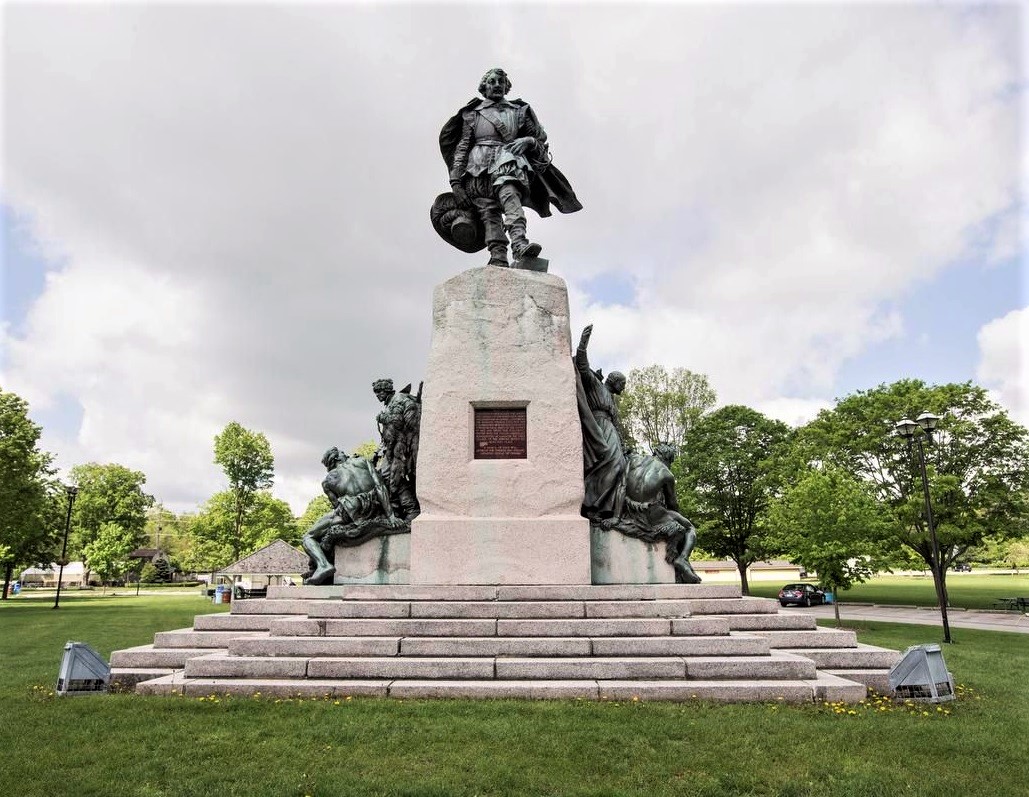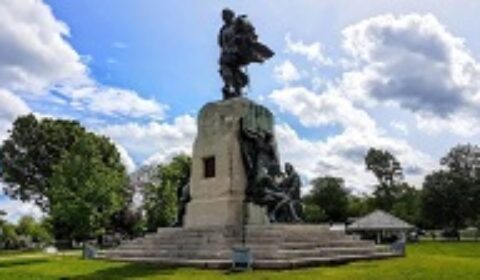CHAMPLAIN RETURNING TO ORILLIA – ALONE – BUT WITH CONTEXT
Mark Clairmont | MuskokaTODAY.com
ORILLIA — Samuel de Champlain will once again look out over Lake Couchiching.
But he will do it alone.
He won’t be surrounded by the subserviant fur trader, missionary and First Nations characters of yore.
At least not now — if ever.
And there will be context in the form of a new plaque explaining his coming and presence there today 400 years after his arrival.
Parks Canada announced Wednesday that the controversial statue will be resurrected immediately in an altered state.

After having the landmark 1925 monument taken down last year, in Couchiching Beach Park in downtown due to some complaints, a joint committee of Parks Canada, the City of Orillia, its citizens and local Indigenous representatives, have come up with an alternative solution to what some considered to be offensive and inappropriate by today’s politically correct standards.
Parks Canada said it will implement the Recommendations of the Samuel de Champlain Monument Working Group in full.
They key ones were:
- That the Samuel de Champlain Monument be re-installed with only the central figure of Samuel de Champlain atop the plinth and that this installation occur immediately.
- That the First Nations figures along with the figures of the Fur Trader and Missionary be the subject of further consultation with First Nations. It is the hope of the Samuel de Champlain Monument Working Group that future work, with the aim of re-imagining their presence in the immediate vicinity of the original Monument, will result in a meaningful and concrete example of Reconciliation.
- That the text of the original Monument’s “in-set plaque” be updated so that it will honour the original intent within the context of contemporary knowledge and wisdom.
- That additional interpretive signage/pieces be developed and created with the participation of First Nations representatives to tell a historically accurate story of Samuel de Champlain and his relationship with First Nations.
- And that further consultation with stakeholders, including First Nations and the City of Orillia, about the plaque text and the other figures will take place later this year.
Parks Canada says in its release that the re-imagining of the monument and its associated figures will detail a more complete history of Champlain’s arrival in the area in 1615 and his interactions with First Nations, providing much needed context.
Further consultation with stakeholders, including First Nations and the City of Orillia, about the plaque text and the other figures will take place later this year.
 Parks Canada says it thanks the working group for their efforts, and the residents of Orillia and surrounding communities who have provided invaluable and thoughtful feedback as part of the consultation.
Parks Canada says it thanks the working group for their efforts, and the residents of Orillia and surrounding communities who have provided invaluable and thoughtful feedback as part of the consultation.
Parks Canada says its decision was informed by many considerations, including the feedback from the public consultation and the final recommendations of the working group.
The government of Canada acknowledges that the Samuel de Champlain Monument is a testament to the skill of the artist and the values of its visionaries. The working group’s recommendations provide an avenue for change and education that both honours the past and looks towards a future where meaningful reconciliation can occur within the context of contemporary knowledge and wisdom.
Parks Canada says it the new monument will better reflect the diverse heritage of the nation and provide an opportunity for Canadians to learn more about our rich and varied history, including the history, cultures, and contributions of Indigenous peoples.
It says this decision is in line with the agency’s Framework for History and Commemoration, which outlines a new approach for sharing more inclusive stories of Canada through diverse and sometimes complex perspectives, including the difficult periods of its past.
